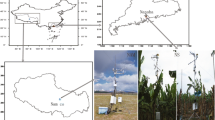Summary
The surface energy exchange of 12m high Scots pine plantation at Hartheim, Germany, was measured with a variety of methods during a 11-day period of fine weather in mid-May 1992. Net radiation and rate of thermal storage were measured with conventional net radiometers, soil heat flux discs and temperature-based storage models. The turbulent fluxes discussed in this report were obtained with an interchanging Bowen ratio energy budget system (BREB, at 14 m), two one-propeller eddy correlation systems (OPEC systems 1 and 2 at 17m), a 1-dimensional sonic eddy correlation system (SEC system 3) at 15 m, all on one “low” tower, and a 3-dimensional sonic eddy correlation system (SEC system 22) at 22 m on the “high” tower that was about 46 m distant. All systems measured sensible and latent heat (H and LE) directly, except for OPEC systems 1 and 2 which estimated LE as a residual term in the surface energy balance. Closure of turbulent fluxes from the two SEC systems was around 80% for daytime and 30% for night, with closure of 1-dimensional SEC system 3 exceeding that of 3-dimensional SEC system 22. The night measurements of turbulent fluxes contained considerable uncertainty, especially with the BREB system where measured gradients often yielded erroneous fluxes due to problems inherent in the method (i.e., computational instability as Bowen's ratio approaches −1). Also, both eddy correlation system designs (OPEC and SEC) appeared to underestimate |H| during stable conditions at night. In addition, both sonic systems (1- and 3-dimensional) underestimated |LE| during stable conditions. The underestimate of |H| at night generated residual estimates of OPEC LE containing a “phantom dew” error that erroneously decreased daily LE totals by about 10 percent. These special night problems are circumvented here by comparing results for daytime periods only, rather than for full days. To summarize, turbulent fluxes on the low tower from OPEC system 2 and the adjacent SEC system 3 were in reasonable agreement, while the BREB system appeared to overestimate H and underestimate LE; H and LE measured by SEC system 22 on the high tower were lower than from OPEC and SEC3 on the low tower. The turbulent flux measurements tended to converge, but the data exhibit unexplained differences between days, between systems, and between locations.
Similar content being viewed by others
References
Amiro, A., Wuschke, E. E., 1987: Evapotranspiration from a boreal forest drainage basin using an energy balance eddy correlation technique.Bound. -Layer Meteor. 38 125–139.
Bernhofer, Ch., 1992: Estimating forest evapotranspiration at a non-ideal site.Agric. For. Meteor. 60 17–32.
Bernhofer, Ch., Gay, L. W., Laube, W., Klug, W., 1992: Ein österreichisch-amerikanisches Bowenverhältnis-Energiebilanzmeβsystem.Wetter und Leben 44 83–106.
Blanford, J. H., Gay, L. W., 1992: Tests of a robust eddy correlation system for sensible heat flux.Theor. Appl. Climatol. 46 53–60.
Bowen, I. S., 1926: The ratio of heat losses by conduction and evaporation from any water surface.Phys. Rev. 27 779–787.
Garthe, H.-J., 1985: Über das langjährige Verhalten der Energiehaushaltskomponenten eines mitteleuropäischen Kiefernwaldes. Dissertation, Univ, Freiburg. 107 pp.
Gay, L. W., Vogt, R., Kessler, A., 1996: The May–October energy budget of a Scots pine plantation at Hartheim, Germany.Theor. Appl. Climatol. 53, 79–94.
Granier, A., Biron, P., Köstner, B., Gay, L. W., Najjar, G., 1996: Comparison of xylem sap flow and water vapor flux at the stand level and derivation of canopy conductance for scots pine.Theor. Appl. Climatol. 53, 115–122.
Horst, T. W., 1973: Corrections for response errors in a three-component propeller.J. Appl. Meteor. 12 716–725.
Jaeger, L., Kessler, A., 1996: The HartX period of May 1992, seen against the background of twenty years of energy balance climatology at the Hartheim pine forest.Theor. Appl. Climatol. 53, 9–21.
McBean, G. A., 1972: Instrument requirements for eddy correlation measurements.J. Appl. Meteor. 11 1078–1084.
Oke, T. R., 1987:Boundary Layer Climate. New York: Wiley.
Ohmura, A., 1982: Objective criteria for rejecting data for Bowen ratio calculations.J. Appl. Meteor. 21 595–598.
Parlow, E., 1996: The Regional Climate Project REKLIP—an overview.Theor. Appl. Climatol. 53, 3–7.
Spittlehouse, D. L., Black, T. A., 1979: Determination of forest evapotranspiration using Bowen ratio and eddycorrelation measurements.J. Appl. Meteor. 18 647–653.
Sturm, N., Reber, S., Kessler, A., Tenhunen, J., 1996: Soil moisture variation and plant water stress at the Hartheim Scots pine forest.Theor. Appl. Climatol. 53, 123–133.
Swinbank, W. C., 1951: The measurement of vertical transfer of heat and water vapor by eddies in the lower atmosphere.J. Meteorol. 8 135–145.
Vogt, R., 1995: Theorie, Technik und Analyse der experimentellen Flußbestimmung am Beispiel des Hartheimer Kiefernwaldes. Ein Beitrag zu den Energiebilanzuntersuchungen im REKLIP.stratus 3, Diss. Phil-. Nat. -Fak. Univ. Basel.
Vogt, R., Bernhofer, Ch., Gay, L. W., Jaeger, L., Parlow, E., Wicke, W., 1996: The available energy during HartX: what's up for partitioning?Theor. Appl. Climatol. 53, 23–31.
Vogt, R., Jaeger, L., 1990: Evaporation from a pine forest — using the aerodynamic method and Bowen ratio method.Agric. For. Meteor. 50 39–54.
Webb, E. K., Pearman, G. I., Leuning, R., 1980: Correction of flux measurements for density effects due to heat and water vapour transfer.Quart. J. Roy. Meteor. Soc. 106 85–100.
Author information
Authors and Affiliations
Additional information
With 7 Figures
Rights and permissions
About this article
Cite this article
Gay, L.W., Vogt, R., Bernhofer, C. et al. Flux agreement above a Scots pine plantation. Theor Appl Climatol 53, 33–48 (1996). https://doi.org/10.1007/BF00866409
Received:
Revised:
Issue Date:
DOI: https://doi.org/10.1007/BF00866409



